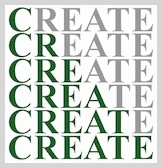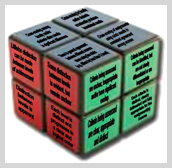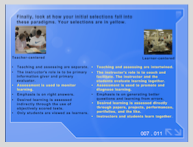assessment
Final Project
26/Feb/2011 12:42 PM

Comments
Rubrics and Assessment
18/Feb/2011 10:22 PM

The common thread that runs through all three articles is that the greatest learning takes place within the confines of shared experiences, collaborating with other people, and learning from each other. It is our job as online instructors to design the best course possible which includes higher reaching goals and objectives, complex thinking activities, self-analysis, and social interaction. We then facilitate students to reach higher levels of learning through coaching, community, and collaboration.
After reviewing the objectives and activities of my final project on Differentiated Instruction in context of the readings, I have included the aims of constructivist learning in my course. However, I realized that I was missing the collaborative piece. I went back to my plan and modified some of the activities to be more interactive and collaborative.
I had a revelation while working on the rubrics for the assessments in my final project. I came to the conclusion that analytical rubrics had the potential to keep students from doing their absolute best and performing with the highest achievement. Many students will “settle” for second best because it is “good enough” for them or they might think it’s too difficult to attain the highest proficiency level. Rick Wormeli in his book, “Fair Isn’t Always Equal: Assessing & Grading in the Differentiated Classroom” supports this idea. To overcome this limitation of analytical rubrics, I created a rubric with three proficiency levels, Exceeds Expectations, Meets Expectation, and Needs Revision. With this system, I could set the criteria very high for the Meets Expectations and reward those who would go above and beyond. At the same time, students who didn’t meet the expectation would have to revise their product until it did. I was assured that every student achieve the objective by meeting the expectation.
While this was an improvement, it still had the potential for students to only meet the expectation. Wormeli presents a different analytical rubric by which only the criteria for a “Standard of Excellence” is specifically spelled out. Students only see the “above and beyond” and work towards it. I’ve decided that I will use this style of rubric for my final project.
A Trip Down Curriculum Lane
10/Feb/2011 09:37 PM

I can remember a few incidents that dramatically changed who I was as a teacher. One such incidents was a week long class I took in the early 90’s. The class was about developing instructional units for middle school students. We learned how to design units that incorporated Bloom’s Taxonomy with product based learning. It was the first time I had heard the terms “rubric,” “multiple intelligences,” and “learning styles.” The instructor was incorporating current research in gifted education into classroom instruction for all students. I loved the idea of it all and fully embraced the concepts. I started planning and teaching with these ideas immediately. I even used the unit design in my Master’s thesis on integrating different subjects into a middle school science class. In a way, my story reminds me of Dr. Cynthia L. Corritore from Creighton University and how she transformed her teaching.
It has been 13 years since I planned my own instructional units. For the final project of this Assessment class, I started to use the old familiar planning grid I used to develop a unit. On the grid, Bloom’s Taxonomic levels are written across the top and down the first column from simple to complex are the concepts or big ideas of the unit. I posted an example of the planning grid on the discussion board and some of my classmates liked the style. One asked if I owned the copyrights. Of course I don’t, but I thought I should try and find out to give credit to the real author. I couldn’t remember who presented to me way back when, so I searched and found it! I’ve been using the Curry/Samara model for curriculum design. It was like finding an old friend. I did make one mistake though. Instead of the two highest levels of Bloom’s (Synthesize and Evaluate) that I used, Curry & Samara use Creative Thinking and Critical Thinking.
For the final project, I have decided that each module will be a separate big idea. From there, I developed learning objectives and activities. I also took Dr. Khalsa’s suggestion to include a separate assessment field, and my classmate’s suggestion (Thank you, Ellen) to include an analysis of current students. You can view the draft document here.
Assessment Toolbox
04/Feb/2011 05:08 PM

I worked with Albana and Tania on the Assessment Toolbox midterm project. I think we used technology well, especially using Skype for conferencing and instant messages. We mostly worked independently on our assigned components of the project and e-mailed our tool descriptions to each other. I assembled all of the documents into the web site. I chose to write about Google Apps as a collaboration and assessment tool. Did you notice I mentioned we e-mailed our documents to each other? Isn’t it ironic that I researched how to use Google Apps to work collaboratively in a new way and we worked together the old way!
We’ve spent a good amount of time in class reading about and discussing how to write a good learning objective. Last week, we created a concept map with sample objectives. This week, a component of the midterm project was to write at least one learning objective connected to the use of the assessment tool. On the message board we even discussed how to effectively convert learning objectives for an online course. I think a discussion about standards and benchmarks, a key component of learning objectives, was left out. National, state, and local standards define the knowledge and skills students are expected to know at each grade level. The benchmarks determine the level to which a standard must be obtained to be proficient.
Standards and benchmarks are used to guide instruction so that content gaps and overlaps do not occur. A teacher needs to create his or her learning objectives so that the expected standards and benchmarks are met. By using standards and benchmarks, most of the work in creating an objective is already done. This frees up the teacher to be more creative in planning how the objectives will be met. For future Assessment in eLearning classes, I think it would be beneficial if a discussion about standards and benchmarks was held before students begin to write objectives.
Assessing Online Learning
30/Jan/2011 10:36 AM

In the class discussion forum, I mentioned Bonk’s observation that, “there still isn't one place that incorporates them all” is still true today. However, after further pondering, I think that was incorrect. The course management system, Moodle, is a flexible system that utilizes plugins and modules to increase its functionality. Because Moodle is open source software, anyone is able to develop their own learning modules and share them with the rest of the community. As a result, the activities that Bonk mentioned, “concept mapping, timelines, debate, brainstorming, comparison and contrast, role play, reflective writing, virtual teaming, and article critiques” can all be added to the system and therefore, one place does incorporate them all. I strongly suggest that anyone who is interested in online learning to investigate Moodle as their course management system.
Concept Maps
25/Jan/2011 10:51 PM
Click on the graphic to enlarge the image. This week we are exploring concept maps. My map highlights three objectives of a future online class for teachers about Differentiated Instruction. The activity shown for each objective is just one of several that the students will complete in order to learn the particular objective. The assessments I’ve chosen are all authentic and product based and will allow the student to demonstrate their achievement of the objectives.
Blogs as Assessments
22/Jan/2011 03:27 PM

I have to admit that prior to this week I did not see any real advantage to using a blog in a classroom, especially for assessment. If you read my previous post, you might get the feeling that that last sentence was quite contradictory to my constructivist views. It took a bit of persuading for me to see the advantages and power that a classroom blog can bring to student learning. I think the greatest benefit of using a blog is that students are able to build on their own knowledge and understanding. Then they can take it further through the interactions and clarifications with peers who can “speak” in the same language.
For many teachers, the mindset of the student in charge of his or her own learning can be difficult and threatening. Not for me though. I have always embraced it and now I’ve added another tool to my belt.
Teacher-Centered or Learner-Centered
19/Jan/2011 09:30 PM

One of the reforms it ushered in at my university was a “paradigm shift” in how science should be taught. The jargon that we used at the time was, “hands-on,” “experimental,” and “student exploration.” From that experience, I put those ideas into action in my own teaching. I soon realized how powerful the constructivist model of learning can be for students. I even structured student assessments to be learner-centered through lab practicals and products.
One area in the survey that didn’t match up was, “Assessment is used to monitor learning.” Monitoring student learning is absolutely critical to drive instruction. I also didn’t select, “Emphasis is on generating better questions and learning from errors.” While I tend to be more learner-centered with my assessments, they don’t always match up with the national drive for high-stakes tests that have become so prevalent.
A New Course Begins
16/Jan/2011 03:23 PM
I get to know another student in a new course through an e-mail conversation. Read More...

